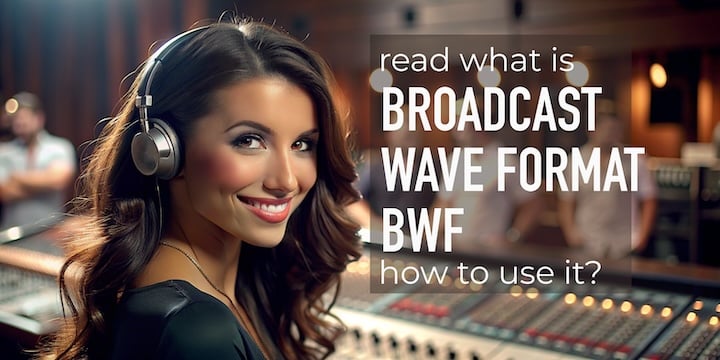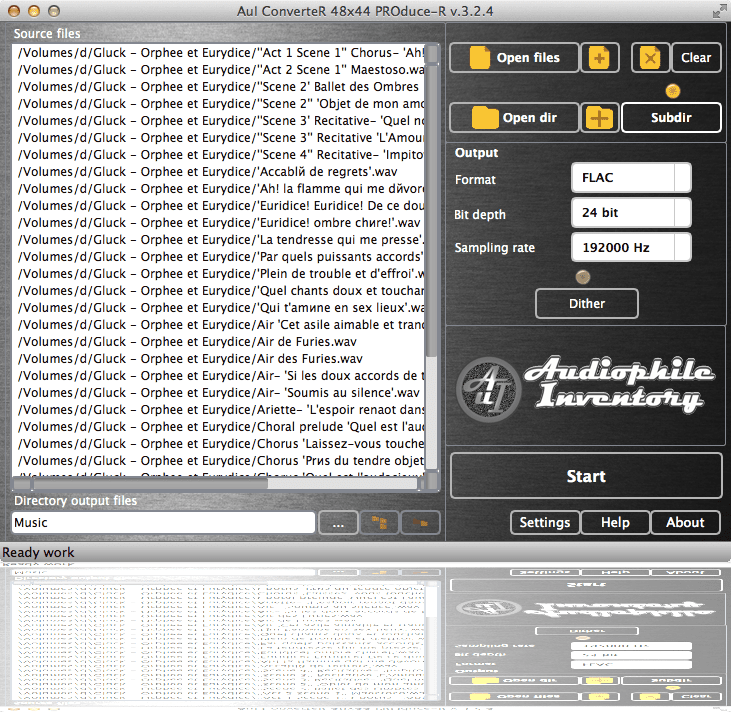
Broadcast Wave Format (BWF) is an extension of Microsoft WAV audio files. Read about BWF destination, content, and others.

If you buy "AuI ConverteR PROduce-RD" (2023/12.x version) from 24 August 2023 to 24 October 2023, you will get free update to version 2024 (13.x) after its release.

What is BWF?
WAV file contains information blocks (chunks): audio data parameters, audio track metadata, etc. BWF is a special additional WAV-chunk that allows:
- add more information for music production applications;
- information to unite several audio files in single stuff (see 'time reference' below);
- information about the loudness level of the audio file content. It's used for level normalization in broadcast applications.
Also, there is Multi-channel Broadcast Wave Format (MBWF) that is intended to storing of multichannel files with size above 4 GByte inside RF64 format.
Read details RF64 MBWF >
Back to top
Versions
Version 0
- description of the sound sequence;
- name of the originator;
- reference of the originator;
- origination date;
- origination time;
- first sample count since midnight (time reference);
- version of the BWF;
- reserved data;
- history coding.
This BWF chunk contains description of coding process that is applied to the audio data. Each new coding application shall add a new string with the appropriate information. AuI ConverteR 48x44 according EBU R98 add "A=PCM,F=44100,W=16,M=mono,T=AuI ConverteR 48x44," string, where:
A - Coding Algorithm;
F - Sampling frequency, Hz;
W - Word Length, bits;
M - mode;
T - free text.
Version 1
UMID for an audio file is added to the reserved data area.
- SMPTE UMID.
UMID (Unique Material Identifier) is a special code that is used to identify audiovisual materials (locally generated and globally unique identifier, standardized by the Society of Motion Picture and Television Engineers (SMPTE)).
Version 2
Loudness measurements for audio file is added to the reserved data area.
For regularize of values of loudness for different broadcast programs (as example, ads and movies), it needs to normalize the loudness of audio files. Audio files must contain their measured level of loudness too. Used algorithm is intended for objective estimation of subjective loudness. It's applicable for various program genres.
- Integrated Loudness Value of the file in LUFS (measured by AuI ConverteR 48x44 according to ITU-R BS.1770-2) for multichannel files also;
- Loudness Range of the file in LU (measured by AuI ConverteR 48x44 according to EBU – TECH 3342);
- Maximum True Peak Level of the file expressed as dBTP (while it's not measured by AuI ConverteR 48x44);
Analog Digital Converter can bypass some peaks of level input signal. Then make oversampling possible restore this peaks: appear increasing of signal level (max 0.688 dB - see Rec. ITU-R BS.1770-2, p. 21).
- Highest value of the Momentary Loudness Level of the file in LUFS (measured by AuI ConverteR 48x44);
- Highest value of the Short-Term Loudness Level of the file in LUFS (measured by AuI ConverteR 48x44).
Back to top
BWF compatible converter
Back to top
BWF editor
Back to topFrequently Asked Questions
What is a Broadcast Wave file?
Broadcast Wave file is a .wav file that contains BEXT chunk (information block).
Read more...
- EBU Tech 3285 - Specification of the Broadcast Wave Format (BWF) - Version 1 - second edition (2001)
- EBU Tech 3285-s1 - Specification of the Broadcast Wave Format (BWF) - Supplement 1, MPEG Audio - first edition (1997)
- EBU Tech 3285-s2 - Specification of the Broadcast Wave Format (BWF) - Supplement 2, Capturing Report - first edition (2001)
- EBU Tech 3285-s3 - Specification of the Broadcast Wave Format (BWF) - Supplement 3, Peak Envelope Chunk - first edition (2001)
- EBU Tech 3285-s4 - Specification of the Broadcast Wave Format (BWF) - Supplement 4, Link Chunk - first edition (2003)
- EBU Tech 3285-s5 - Specification of the Broadcast Wave Format (BWF) - Supplement 5, <axml> Chunk - first edition (2003)
- EBU Tech 3352 - The Carriage of Identifiers in the Broadcast Wave Format (BWF) (2012 Recommendation)
- BWF Metadata editor
- Loudness normalisation and permitted maximum level of audio signals (EBU – Recommendation R 128)
- Algorithms to measure audio programme loudness and true-peak audio level (Recommendation ITU-R BS.1770-3)
- Loudness Range: A measure to supplement loudness normalisation in accordance with EBU R 128 (EBU – TECH 3342)
- Practical guidelines for Production and Implementation in accordance with EBU R 128 (EBU – TECH 3343)
- Format for the <CodingHistory> field in Broadcast Wave Format files, BWF (EBU Technical Recommendation R98)
- Test files for control measurement instruments (Compliance material for Recommendation ITU-R BS.1770. Report ITU-R BS.2217)
Back to top
